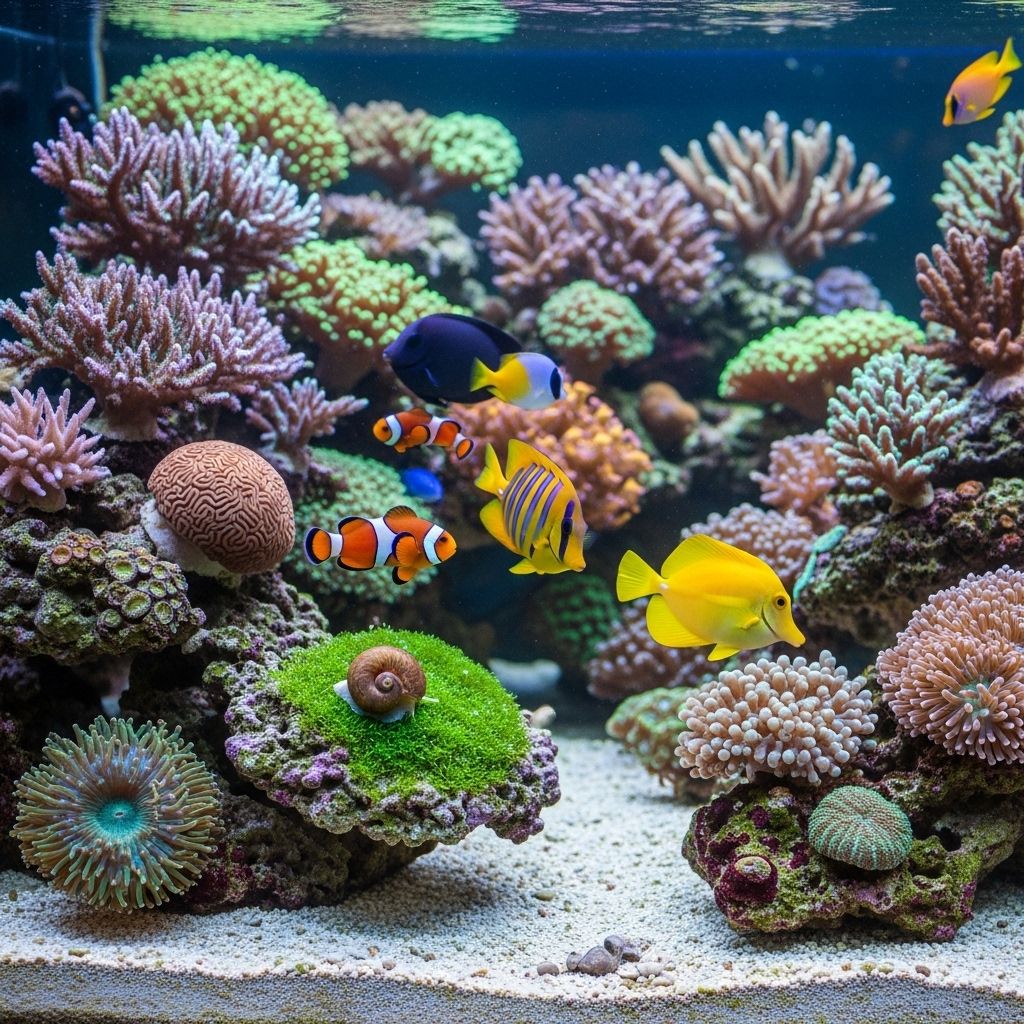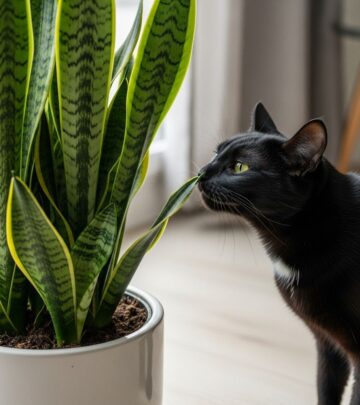How to Control Algae in Your Saltwater Aquarium
Balanced nutrients and proper flow support a vibrant reef setup and pristine surfaces.

Image: HearthJunction Design Team
Keeping a saltwater aquarium vibrant and healthy requires vigilance—especially when it comes to battling unwanted algae. Algae can quickly overrun your tank, clouding water, smothering corals, and detracting from the natural beauty you work hard to create. Fortunately, with proactive maintenance and proven strategies, you can control and even prevent troublesome algae in your saltwater system.
Understanding Algae in the Marine Aquarium
Algae are photosynthetic organisms, ranging from microscopic phytoplankton to visible green, brown, or red growths. In moderation, they are part of a healthy reef ecosystem, providing food and oxygen. However, uncontrolled algae blooms—most often due to excess nutrients—can suffocate corals, clog filtration, and harm fish and invertebrates. The most common types found in saltwater tanks include:
- Green Hair Algae: Fine, fuzzy threads on rocks and glass.
- Bubble Algae: Translucent green spheres, often hard to remove.
- Film Algae: Thin, green or brown coating on surfaces.
- Red Slime (Cyanobacteria): Reddish, slimy mats with a rapid spread.
- Diatoms: Brown dusting that appears on new tank setups.
While some algae are harmless or even beneficial in small quantities, unchecked growth is a clear sign of imbalance—usually a result of excess nitrates and phosphates.
Why Does Algae Flourish?
The main causes of algae overgrowth are:
- Elevated nutrients (nitrate and phosphate) from overfeeding, poor filtration, or decaying organic matter.
- Excessive lighting, often from high-intensity fixtures or lights left on too long.
- Insufficient water movement, leading to “dead zones” where detritus accumulates.
- Infrequent water changes or poor aquarium maintenance routines.
Finding and correcting the root of your algae problem is essential to long-term success.
Key Strategies to Control and Prevent Algae
Algae management requires a combination of tactics. Here is a comprehensive guide to the most effective strategies:
1. Control Nutrient Levels
Nutrient management is critical for algae control. High levels of nitrate (NO3) and phosphate (PO4) are a primary contributor to blooms. Try these steps:
- Reduce Feeding: Feed sparingly, offering only what your fish will consume in a few minutes. Remove uneaten food promptly.
- Perform Regular Water Changes: Swap 10–20% of your tank’s water weekly to dilute accumulated nutrients.
- Use RODI Water: Always fill your aquarium and make top-offs using purified RODI (reverse osmosis deionized) water to avoid introducing unwanted nutrients.
Mechanical filtration (filter pads, socks) and protein skimmers physically remove organic debris before it decomposes and releases nutrients.
2. Consider a Refugium
Refugiums are compartments in your sump or a separate tank where macroalgae (typically Chaetomorpha) grows under strong light. As the macroalgae grows, it absorbs nitrate and phosphate, competing with nuisance algae for nutrients. Periodically harvest the macroalgae to export nutrients from your system. Ensure proper lighting for the refugium—LED grow lights are highly effective.
3. Choose the Right Cleanup Crew
Herbivorous snails, crabs, and fish play a significant role in controlling algae, grazing on growth before it overwhelms the system. Consider adding:
- Turbosnails, Astrea snails, and Trochus snails: Effective for eating film and hair algae.
- Emerald crabs: Known to consume bubble algae.
- Hermit crabs (caution required): Useful but may prey on snails.
- Blennies and tangs: Some species graze on algae mats.
Be sure to stock appropriately for your aquarium size and avoid crowding, which can stress animals and reduce efficiency.
4. Manually Remove Algae
Manual removal should be your first response to visible algae problems. Steps include:
- Scraping glass and rocks: Use algae scrapers or pads for glass, and remove rocks to scrub under running water if feasible.
- Twisting hair algae: A toothbrush can help remove hair algae; twirl the brush around to pull up clumps.
- Siphoning: During water changes, siphon out as much algae as possible.
Regular manual maintenance prevents minor outbreaks from escalating.
5. Optimize Lighting
Lighting fuels algae. To keep it in check:
- Reduce intensity and duration: Start with short periods (2–3 hours daily for a week), then increase incrementally until you find the balance.
- Avoid direct sunlight: Position your tank away from windows.
- Replace aging bulbs: Deteriorating light spectrum can support nuisance algae growth.
For tanks with live corals, ensure you meet their needs without over-exposing the tank to excess light. Use timers for consistency.
6. Use Phosphate Removers (Chemical Media)
Phosphate-removing filter media, such as granular ferric oxide (GFO), are effective at binding and removing phosphate from aquarium water, starving algae and limiting regrowth. Change phosphate media as recommended by the manufacturer—usually every 2–3 months.
7. Employ Protein Skimmers
Protein skimmers are invaluable for reef systems, removing dissolved organic matter before it breaks down into nitrate and phosphate. They also:
- Improve water clarity
- Increase oxygenation
- Reduce overall maintenance
8. Consider Hydrogen Peroxide Treatments and UV Sterilization
Hydrogen peroxide can be used for spot-treating localized algae outbreaks or dosing the tank as a whole. Spot treatment often involves carefully applying diluted peroxide to affected areas using a syringe, while whole-tank treatments require precision to avoid harming sensitive livestock.
UV sterilizers attack free-floating algae spores, reducing green water and preventing some persistent outbreaks. For best results, combine these advanced methods with strong nutrient control.
9. Increase Plant Biomass Where Appropriate
If your aquarium can support it, increasing plant (or macroalgae) biomass will outcompete problem algae for light and nutrients. Aim to cover 70–80% of suitable surfaces with macroalgae or seagrasses. This is especially effective in mixed or macroalgae-based displays, or in refugiums.
Common Algae Types and Their Control Methods
| Algae Type | Description | Control Methods |
|---|---|---|
| Green Hair Algae | Fine, fuzzy, green strands, fast-growing | Manual removal, nutrient reduction, snails/blennies |
| Bubble Algae | Round, green bubbles; hard to eradicate | Manual removal (carefully), emerald crabs |
| Film Algae | Thin, green or brown film on surfaces | Regular scraping, snails, improve flow |
| Red Slime (Cyanobacteria) | Reddish/purple slimy sheets, rapid spread | Increase flow, nutrient reduction, siphon, lights out |
| Diatoms | Brown powder; often in new tanks | Wait it out, reduce silicates, clean-up crew |
What to Avoid When Fighting Algae
- Do not overuse chemical treatments or algaecides; these can harm beneficial organisms and disrupt tank stability.
- Never ignore the root cause; algae are a symptom of excess nutrients or imbalance.
- Avoid overcrowding clean-up crews; more is not always better.
- Don’t neglect routine maintenance; consistency is key.
Troubleshooting Persistent Algae Problems
If algae persist despite your best efforts:
- Test your water: Check nitrate, phosphate, and silicate levels. Identify hidden nutrient sources such as decaying livestock, old filter media, or contaminated top-off water.
- Inspect equipment: Ensure your protein skimmer and filtration are functioning optimally.
- Check for ‘dead zones’: Adjust powerheads to eliminate stagnant areas where detritus can accumulate.
- Re-evaluate livestock and feeding: Ensure your bioload is appropriate for your filtration capability.
Advanced methods such as hydrogen peroxide treatments and UV sterilization can give short-term control, but always combine these with robust long-term nutrient management for lasting results.
Frequently Asked Questions (FAQs)
What is the safest way to remove hair algae?
Manual removal using a toothbrush is very effective for hair algae, especially when combined with careful nutrient management and regular water changes. Herbivorous snails and blennies can help prevent regrowth.
How much light should I provide to minimize algae?
Start with 2–3 hours per day and slowly increase, observing for algae growth. Make lighting adjustments based on your tank’s unique needs and the sensitivity of your corals and other inhabitants.
How do I reduce phosphate in my saltwater tank?
Use phosphate-absorbing filter media like GFO or other commercial removers, reduce feeding, and perform regular water changes. Maintaining a refugium with rapidly growing macroalgae also absorbs phosphate.
Is hydrogen peroxide safe for marine tanks?
Hydrogen peroxide can be used, but must be dosed carefully to avoid harming sensitive fish, invertebrates, or corals. Always follow expert guidelines and monitor livestock during and after treatment.
Why do new tanks get brown algae (diatoms)?
Diatoms are common in new aquariums due to high silicate levels and natural cycling. They usually disappear on their own after a few weeks. Perform water changes, reduce silicate imports, and maintain a healthy clean-up crew.
How important is water flow in controlling algae?
Strong, consistent water movement helps prevent debris accumulation and discourages algae settlement. Adjust powerheads to eliminate “dead spots” where algae can take hold.
Summary Table: Algae Control Methods
| Method | Effectiveness | Best For |
|---|---|---|
| Manual Removal | Rapid, short-term | Visible outbreaks, hair/film algae |
| Cleanup Crews | Ongoing maintenance | All types, prevention |
| Refugium | Long-term, nutrient export | Nitrate and phosphate reduction |
| Phosphate Removers | Medium-high | Phosphate control, GHA prevention |
| Hydrogen Peroxide | Short-term spot/control | Localized stubborn outbreaks |
| UV Sterilization | Prevention, water clarity | Green water, spore reduction |
| Lighting Adjustment | Long-term, preventative | Film/fuzzy algae, cyano |
Final Thoughts
An algae-free saltwater aquarium is a sign of good husbandry, balance, and care. By combining strong filtration, nutrient control, careful lighting management, and the right cleanup crew, you can enjoy a pristine marine environment. Address outbreaks quickly, monitor water chemistry regularly, and remember: prevention always beats cure in marine aquariums. With patience and diligence, you’ll keep your saltwater tank healthy and your livestock thriving.
References
- https://www.mantasystems.net/a/blog/post/hydrogenperoxide-algae
- https://light.fish/blog/best-algae-control-for-aquariums
- https://advancedaquariumconcepts.com/how-to-reduce-nitrate-and-phosphate-in-a-reef-tank/
- https://www.bulkreefsupply.com/content/post/md-2016-12-5-effective-ways-to-control-algae-in-reef-aquariums
- https://www.reef2reef.com/threads/tips-for-algae-control.661720/
Read full bio of Shinta












